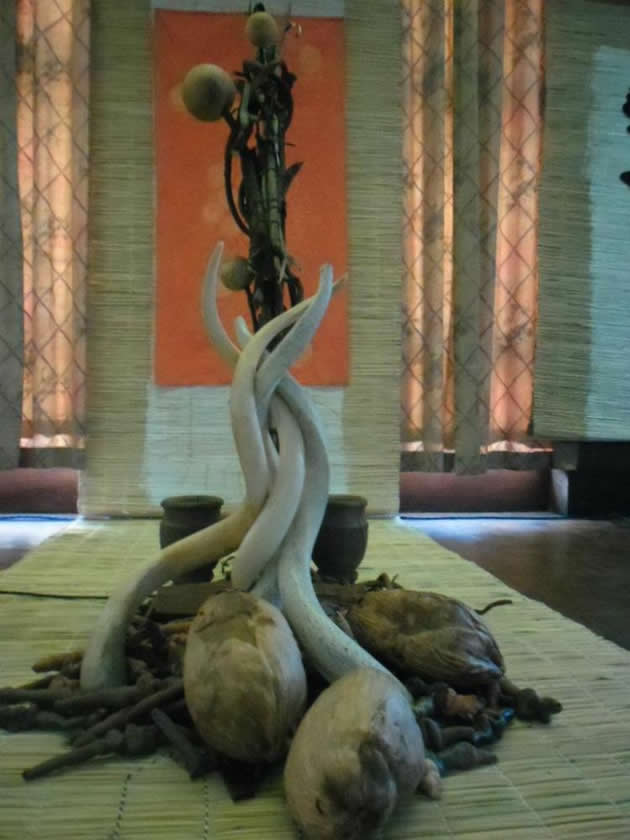Addition and subtraction, the art of sculpture


Three-dimensional assemblages by young Zimbabwean artists Munyaradzi Mazarire and Masimba Hwati’s grouped horns
Knowledge Mushohwe
Three dimensional work refers to artwork that occupies three-axis on a Cartesian co-ordinate system. As opposed to two-dimensional art that has two co-ordinates, X and Y axes, or height and width, three-dimensional art has the advantage of a third facet, a Z axis that represents depth.
Depth is a particular challenge for artists, as it allows the thinking process to encompass creatively defining various angles within one composition.
Three-dimensional workspace encourages artists to broaden their creativity by allowing depiction of artworks as objects. The making of three-dimensional artworks falls within the sculptural genre and there are several ways of creating sculptural products.
The most common form of creating three-dimensional sculptural products in Zimbabwe today is carving.
Carving includes cutting or chipping away a shape from a mass of stone, wood, or other hard material.
Carving is a subtractive form of sculpture that involves systematically eliminating materials from the outside in. The carving process is widely described by artists as the ‘extraction’ of form from within ‘rough’ matter.
The process is primarily dependent on the shape of the mass and the artist has to ‘see’ specific, abstract shapes that collectively form a three-dimensional image.
The centre of the mass and several layers around it remain untouched but the artist.
It is the manipulation of several layers of the exterior, in varying degrees that shows the true craftsmanship of the artist.
In addition to creative thought processes, the artist’s ability to physically extract the excess material is key.
Similar to the ability of the hand to transfer mental images to paper in two-dimensional art, the co-ordination within the artist is just as important as the message that the artwork carries. The direct opposite of subtractive sculpture is a ‘building up’ process and there are several types of this additive technique, including casting, modelling and assembly.
Cast sculptures are made from a material such as metal which, if exposed to extreme temperature change, melts down. The molten substance may then be poured into a mould. Allowing the mould to cool hardens the three-dimensional artwork into a lasting object.
Casting is an execution of a predetermined idea or concept through layering. Modeling involves the manipulation of a soft or malleable material, such as clay being built up and shaped to create a form.
In most rural parts of Zimbabwe, as young boys herd livestock or relax, clay is frequently used to create any of many crafts that strongly resemble real-life things such as animals, huts and people.
Historically, African tribes used clay to model artefacts used for decorative, religious or ritual purposes.
Modelling has played an even bigger role in African societies over the years as it has created objects such as cups, pots and other cooking utensils meant for domestic use.
Modelling is also used in crime labs to determine identities of ‘Jane Does’, unknown murder victims through layering of matter resembling facial tissues on cast equivalent on the skull.
In many instances, the process has been successful in identifying age, sex, ethnicity and other personal characteristics. Another form of creating three-dimensional sculptures called assembling is preferred by many young Zimbabwean visual artists, prominent among them Gareth Nyandoro, Munyaradzi Mazarire, Masimba Hwati and to a lesser extent David Chinyama.
Assemblage artists gather and join different materials to create an amassed sculpture using one or a combination of materials.
Additive techniques require skills in ensuring that bonding of materials is permanent and unlikely to be modified by accidental contact and fluctuations in weather patterns.
Clay modelling for example provides a real challenge to artists as cracks and other abrasion may occur if the soil is sub-standard.
Finishing in sculpture is vital.
Wax is normally applied to stone sculptures as a preservation technique while kiln ‘burning’ for modelled sculptures consolidates the hardening of three-dimensional artworks initiated by drying once the sculpture is completed. Young Zimbabwean sculptors appear to be moving away from the established stone sculpture industry for
which the country is renowned for globally as the saturated genre continues to produce gifted and mediocre artists in equal measure.
Of particular concern is the lack of creativity displayed by roadside artists that master creating one or two images and replicate them several times to earn easy money.
For the ‘real’ sculptors, there is satisfaction in executing their duties.
Sculpture is the art of space that can be experienced through sight, touch and sometimes even sound.
Sculpture is the ultimate reflection of our physical reality because it is experienced physically.
Whether the technique employed is subtractive or additive, sculpture will always fascinate, disturb and provoke thought in viewers. And the viewers will include generations upon generations because, unlike a drawing on paper, the chances of one sculpture surviving for centuries are better.









Comments